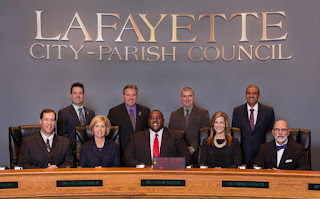On March 22, the Acadiana Group of the Sierra Club and the WaterMark Alliance delivered a letter to local Lafayette leaders asking for immediate actions responding to contamination of our Chicot Aquifer water source and abandoned railyard site downtown. An article in The Independent by Wynce Nolley titled Green alliance offers advice to LCG on water contamination describes this letter and provides additional background information.
Express your opinions and concerns to the Lafayette mayor-president and council! Contact them by phone, email, or postal mail. Contact details for all these leaders are available in the previous post titled Who is my council member? Who is the mayor-president? How do I contact them?
The March 22 letter states in part:
Express your opinions and concerns to the Lafayette mayor-president and council! Contact them by phone, email, or postal mail. Contact details for all these leaders are available in the previous post titled Who is my council member? Who is the mayor-president? How do I contact them?
The March 22 letter states in part:
"The contaminated railyard site next to our downtown and residential neighborhoods perches above water wells that provide much of our municipal water supply. Beyond the obvious risk to neighbors’ health and property resulting from this un-remediated site, we now see clear evidence that it is contaminating our aquifer. Currently, we are pumping millions of gallons of water every day from the LUS water wells near sites of contamination. This continued pumping poses a threat to our aquifer and the future health and prosperity of our city."Evidence of contamination appearing in LUS drinking water wells was presented at a January 19 meeting organized by the Sierra Club. The measured concentrations are below EPA Designated Contaminant Levels and are measured before treatment. However, contaminants reaching our water wells “present a warning to the public and our civic leaders that action is needed” said Harold Schoeffler, chair of the Sierra Club Acadian Group. Attention has been focused on the abandoned railyard in downtown Lafayette since DOTD has revived their plan to construct I-49 over the railyard site which is known to be contaminated with toxic substances including some of those being monitored in nearby LUS wells. Schoeffler went on to say that “both property and public health require protection.” A March 22 letter from the Sierra Club Acadian Group and the WaterMark Alliance to Lafayette Mayor/President Joel Robideaux and Council members makes the following ten recommendations:
- Plan and execute a study of surface contamination within the wellhead protection area of our wells. Include sampling for all contaminants that have been monitored in LUS well water, and for contaminants found at other US rail sites which are either undergoing or have been remediated.
- Where appropriate, partner with other state and federal agencies.
- Intensify sampling of well water by increasing the frequency of sampling and adding contaminants for analysis to include all known or suspected contaminants present on the surface or in the surficial aquifer (groundwater just below the surface).
- Make all past and current well monitoring and sampling data easily available for public review and analysis.
- Begin contingency planning for shutting down all wells in the vicinity of the North Treatment Plant. Abandoning some or all of these wells may be necessitated in the future to allow aquifer remediation through recovery well operation or other groundwater cleaning technology.
- Identify responsible parties and methods to recover ratepayer and taxpayer costs.
- The abandoned railyard site is a public hazard and should be posted as such. It is known to be contaminated with arsenic, asbestos, lead, and many other contaminants which endanger public health from dust and direct contact.
- Public access and parking of any vehicles on the abandoned railyard site should be immediately prohibited.
- Determine new protection measures to be fully integrated into policy.
- Ordinances based on LDEQ drinking water protection sample ordinances should be drafted and adopted.
Schoeffler hopes to see a response to these recommendations at future meetings of the Council and Utility Board.
The letter's civic leader recipients were:
- Joel Robideaux, Mayor-President
- Kevin Naquin, Council Member District 1
- Jay Castille, Council Member District 2
- Patrick Lewis, Council Member District 3
- Kenneth P. Boudreaux, Council Member District 4
- Jared Bellard, Council Member District 5
- Bruce M Conque, Council Member District 6
- Nanette Cook, Council Member District 7
- Liz W. Hebert, Council Member District 8
- William G. Theriot, Council Member District 9
Copies of the letter were provided to Terry Huval, P.E., Director, LUS, and Craig Gautreaux, Water and Wastewater Operations. Manager, LUS. A copy of the signed letter is attached below or can be viewed online by clicking here.
 |
| Page 1 |
 |
| Page 2 |






